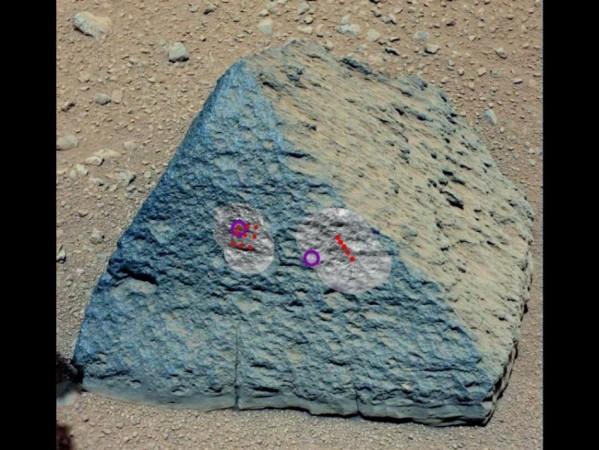
NASA's Curiosity rover has reached out to the first Martian rock, which looks similar to some unusual rocks from Earth's interior. The space agency said that the rock presents more varied composition than expected from previous missions.
To study the chemical makeup of the football-size rock called "Jake Matijevic" (matt-EE-oh-vick), the rover team used two instruments, and the result of the study supports some surprising recent measurements.
"This rock is a close match in chemical composition to an unusual but well-known type of igneous rock found in many volcanic provinces on Earth," said Edward Stolper of the California Institute of Technology in Pasadena, Calif., who is a Curiosity co-investigator.
"With only one Martian rock of this type, it is difficult to know whether the same processes were involved, but it is a reasonable place to start thinking about its origin," he added.
According to NASA, rocks on Earth with composition like that of the Jake are formed by processes in the planet's mantle beneath the crust, from crystallization of relatively water-rich magma at an elevated pressure.
Jake was the first rock analyzed by the rover's arm-mounted Alpha Particle X-Ray Spectrometer (APXS) instrument and about the thirtieth rock examined by the Chemistry and Camera (ChemCam) instrument.
Using improved and faster APXS devices, rover analyzed two penny-sized spots on Jake last month.
"Jake is kind of an odd Martian rock," said APXS Principal Investigator Ralf Gellert of the University of Guelph in Ontario, Canada. "It's high in elements consistent with the mineral feldspar, and low in magnesium and iron."

ChemCam found only one of its kind compositions at each of 14 target points on the rock, hitting different mineral grains within it.
"ChemCam had been seeing compositions suggestive of feldspar since August, and we're getting closer to confirming that now with APXS data, although there are additional tests to be done," said ChemCam Principal Investigator Roger Wiens of Los Alamos National Laboratory in New Mexico.
The wealth of information from the two instruments checking chemical elements in the same rock is just a preview, said NASA in a statement. Curiosity also carries analytical laboratories inside the rover to provide other composition information about powder samples from rocks and soil.
The mission is progressing toward getting the first soil sample into those analytical instruments during a "sol" or Martian day.
"Yestersol, we used Curiosity's first perfectly scooped sample for cleaning the interior surfaces of our 150-micron sample-processing chambers. It's our version of a Martian carwash," said Chris Roumeliotis (room-eel-ee-OH-tiss), lead turret rover planner at NASA's Jet Propulsion Laboratory in Pasadena, Calif.

















